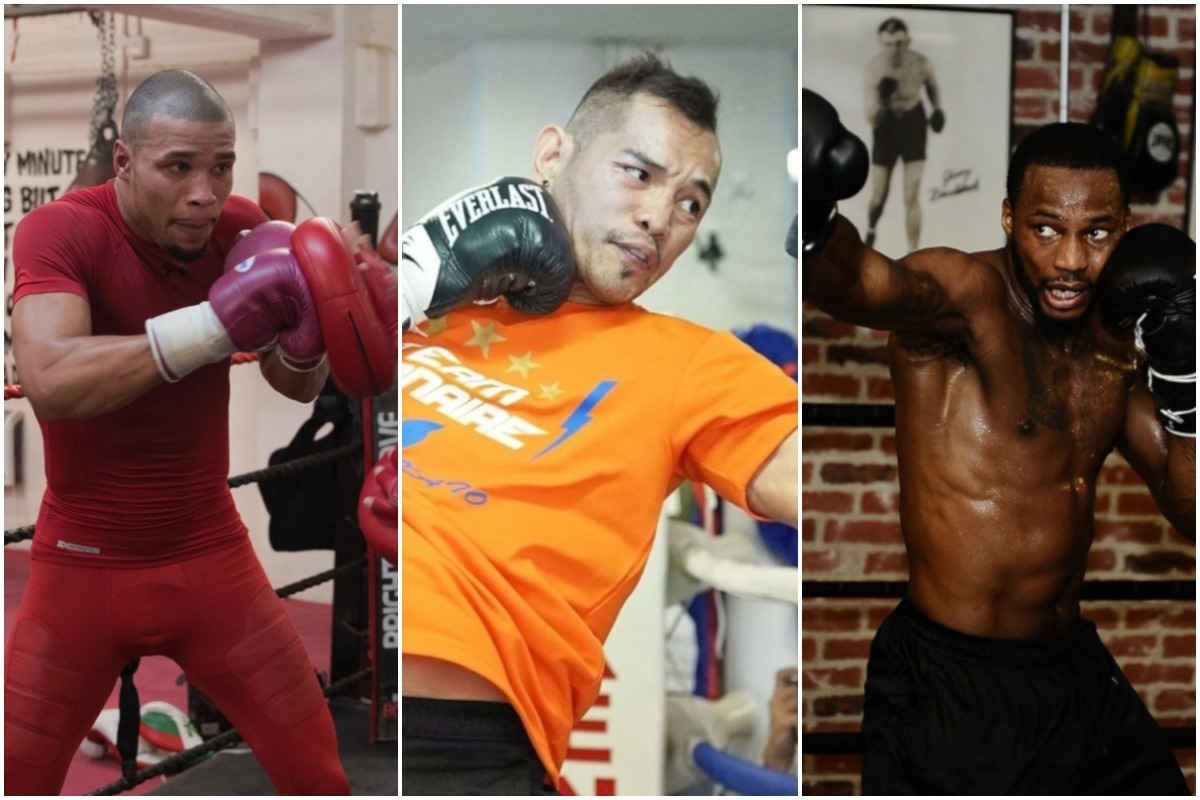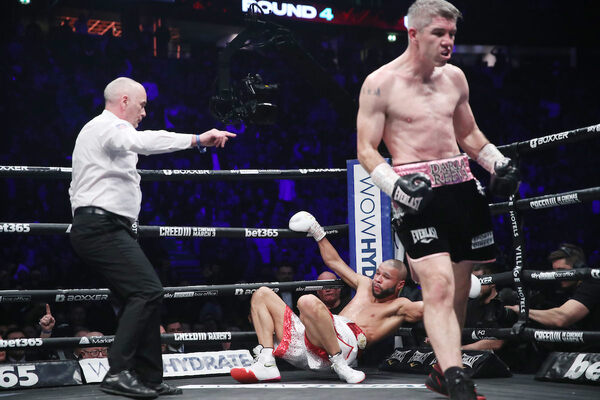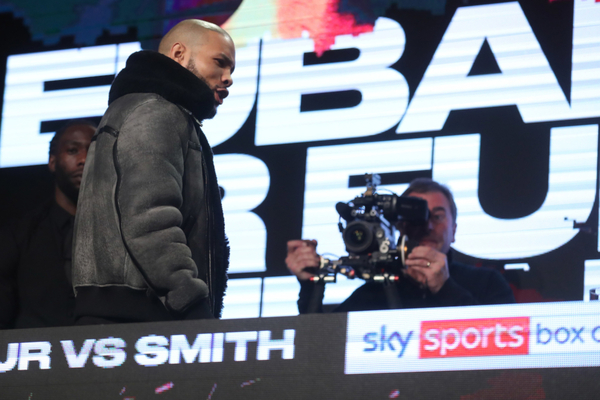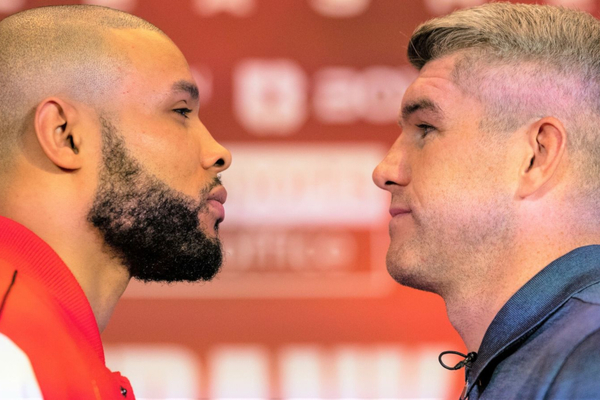Chris Eubank Jr and 9 other boxers who moved down to move forward
Derek Bonnett presents nine fighters who moved down in weight in order to progress their careers, as Chris Eubank Jr is doing, with varying results

Chris Eubank Jr feels the middleweight division is a more natural weight for his boxing career. From October 2014 to June 2016, the prodigal son of the all-time great super-middleweight champion bearing the same name, weighed in at or below the 160lb limit. Prior to that, he hung two-to-four pounds north of the divisional limit. Eubank the Second scored his most salient victories over Arthur Abraham and James DeGale at 168lbs, but he sees opportunity in the possible void left by Canelo Alvarez and Danny Jacobs in the division below. Mainly, Eubank Jr is one of few fighters openly calling out Jermall Charlo in the middleweight division.
Tomorrow night (December 7) at Barclays Center in Brooklyn, New York, both Eubank Jr and Charlo will be featured in separate title bouts to set the stage for future negotiations. But first, Eubank Jr must get past Matt Korobov, a southpaw former world title challenger, who more than a few felt defeated Charlo in 2018. In Korobov, Eubank Jr will be meeting a former 2008 Olympian with a stalwart boxing foundation beneath him. Korobov will possess an advantage in technical prowess to compensate for his deficit in raw knockout power. Eubank Jr, who has grown leaps and bounds since his middleweight defeat to Billy Joe Saunders, should be viewed as the favorite, but is in deep against the increasingly desperate Korobov.
In boxing, the talk of a boxer moving up in weight is more typical. However, Eubank Jr is hardly alone in his descent to a lighter class to find meaningful work. As always in the business of professional prizefighting, the results are mixed. The following are eight boxers who chased opportunity down in weight and their varying fates.
Amanda Serrano
Serrano, 37-1-1 (27), rates among the best women boxers to ever lace up the gloves. In proud Puerto Rican tradition, the Brooklyn-based boxer has built her legacy winning titles. In fact, Serrano’s modus operandi could be described as title-grabbing. From 2011 to 2019, Serrano has picked up seven belts in seven divisions with few defences among them. Serrano, 31, started her career at super-featherweight and won a belt there in 2013 before moving on to lightweight for a strap in 2014. In 2016, Serrano was down to featherweight for another successful title bid. The following year, Serrano dropped down to super-bantamweight to win a belt there in January. By April 2017, Serrano was down to bantamweight for yet another title win. Things got interesting in 2018 as Serrano jumped up twenty pounds to win a belt at super-lightweight. The real surprise came when in her next bout, she shed 24lbs to take the super-flyweight title at a career-lightest 114lbs just this year.
Nonito Donaire
The Filipino Flash’s recent form at bantamweight still has us reeling! Donaire, 37, is in the twilight of a first-ballot Hall-of-Fame career, but still may have another shocker for fans if he can get the right fights. Donaire started his career as a super-flyweight, but made his big splash on the world stage in wrenching the flyweight title from Vic Darchinyan in 2007. Donaire’s prime years carried him to more success and more titles at 115, 118, 122 and 126lbs. However, Donaire also became acquainted with defeat as it become obvious his smaller frame was not carrying his vaunted power to the higher weight classes. Donaire began to resemble a champion on the wrong side of the hill. Following a 2018 featherweight loss to Carl Frampton, Donaire shed 8lbs to compete in the World Boxing Super Series at bantamweight. In his return bout after seven years above the bantamweight limit, Donaire got off to an even start against Ryan Burnett before prevailing by an injury retirement in the fourth. He then walked over substitute Stephon Young in six rounds to land a place in the final with Naoya Inoue. The two produced a strong candidate for 2019 Fight of the Year. Donaire surprised many by standing toe-to-toe with Inoue, hurting him, cutting and pushing him closer to the precipice of defeat than ever before. Inoue’s power broke through in the end and a knockdown of Donaire late sealed his victory. Even still, Donaire, 40-6 (26), proved himself a major factor in today’s bantamweight division.
Akira Yaegashi
Japan’s Yaegashi, 36, is among boxing’s three-division world champions since 2015. However, Yaegashi’s trek was not a simple 1-2-3 in terms of division hopping. Yaegashi won a straw-weight belt in his second try come 2011. He lost it in a Fight of the Year candidate to Kazuto Ioka in 2012, but quickly jumped two divisions to campaign as a flyweight. He dethroned Toshiyuki Igarashi for a flyweight belt in 2013 and held it for three defences before losing to Roman Gonzalez. Following a loss to Pedro Guevara, Yaegashi looked to be headed out to pasture, but he found resurgence in the light-flyweight division after scoring a respectable upset over Javier Mendoza for an alphabet strap in 2015.
Eddie Chambers
Not too long ago, “Fast” Eddie Chambers, 42-5 (23), was one of the slickest heavyweight contenders out there. Although never a champion, he beat many top contenders of his time and lost controversially to some of them as well. After losing a questionable call to Tomasz Adamek at heavyweight, Chambers, who weighed under 210lbs for his world title challenge of Wladimir Klitschko, made his way down to the cruiserweight division in 2013. Chambers shrunk down to 196lbs. He was actually outweighed by three pounds against Thabiso Mchunu in a 10-round contest I happily covered from ringside for SecondsOut. Matters were not so merry for Chambers inside of the ring as Mchunu embarrassed the emaciated and lethargic former heavyweight. Each judge could only spare a single round to Chambers as Mchunu made a name for himself with the career-best victory. The next time we saw Chambers was at heavyweight and he never weighed below 216lbs again.
Chris Byrd
Chris Byrd was underappreciated as a heavyweight contender, but as a heavyweight titlist, he was just plain lucky as champion Vitali Klitschko was forced to retire due to a shoulder injury. Byrd fought as a middleweight in the 1992 Olympics and brought home silver to the USA. His first bout was as a super-middleweight; his second a light-heavyweight; his third a cruiserweight; after that, he was all heavyweight. Byrd, 41-5-1 (22), kept the hand and foot speed of a middleweight. His Olympic pedigree carried him to victories over top veterans and legit heavyweights such as David Tua and Evander Holyfield. After that, some real struggle began as Byrd had to fight much taller and heavier opponents. A pair of losses, to Wladimir Klitschko and then Alexander Povetkin, convinced Byrd it was time to drop in weight. His eyes weren’t on cruiserweight fame though and, instead, he sucked down to light-heavyweight. Byrd was one pound under the limit when he met Shaun George, a vastly less experienced boxer, who never quite established himself as a serious contender. Yet, George dominated Byrd and punished the two-time heavyweight titlist for a ninth-round TKO. Byrd fought once more as a cruiserweight just to go out on a win.
Chad Dawson
The world’s premier light-heavyweight at the time, Chad Dawson agreed to meet Andre Ward and even offered to face him in the super middleweight division. Dawson, now 37, had used speed and athleticism to topple Tomasz Adamek, Glen Johnson, Antonio Tarver and Bernard Hopkins. Shedding those extra pounds cost him his speed and took away most of his athletic capabilities for the Ward challenge. If there’s a cautionary tale on this list, Dawson’s might be it. Dawson was at the height of his prime but Ward dropped a legless “Bad” Chad three times. The light-heavyweight champion could barely mount an offensive; he was that spent. Ward stopped him in the 10th round, but the bout took much more from Dawson. He was blitzed by Adonis Stevenson in little more than a minute next time out. Soon after, he was outpointed by the limited Tommy Karpency. Dawson, 36-5 (19), fights on today, sporadically at best, but he is a skeleton of the fighter who dominated the best light-heavyweights of his era.
Jacob Matlala
The world’s most diminutive boxing champion was just a “giant killer” as I wrote about some months back, but he also shed weight to win a world title in a smaller division. That’s right, Matlala, 53-13-2 (26), captured his first belt in 1993 with a stoppage of Pat Clinton in Glasgow, Scotland. The 4ft 10in boxer weighed in as a flyweight and rallied to win the nip-and-tuck contest inside of the distance. He lost his belt in February 1995, but by November was trying for a light-flyweight title back in Glasgow against Paul Weir. Matlala came in as a straw-weight essentially and edged Weir on technical decision. He repeated the victory by stopping Weir in Liverpool in early 1996. Matlala would go on to score his biggest win as a professional as a light-flyweight when he toppled Michael Carbajal due to cuts in nine rounds.
Charles Williams
“Prince” Charles Williams competed as one of the top light-heavyweights during the late 1980s and early ‘90s. He had already had a six-year reign as champion of that division, which ended on points to Henry Maske in 1993. Yet, Williams had rebounded to stop two rising contenders in the division to position himself back in line. However, Williams opted to drop down to the super-middleweight division to meet James “Light Out” Toney. Toney, still unbeaten at this time, truly lived up to his moniker, having stopped Michael Nunn, Iran Barkley and Tim Littles in dramatic fashion. For most of the contest, Williams was game and brought the fight to Toney or competed with him on near-even terms. Just when it seemed likely that “Prince” Charles would hear the final bell, Toney put the lights out on him. Williams had not been stopped in 13 years and was simple too gassed to get himself together following the late-rounds assault from the champion. Williams would move back up and take part in two of the most brutal light-heavyweight bouts of the mid-90s, but something never came back to him after his super-middleweight venture.
Sung Kil Moon
Moon, a 1984 Olympian for South Korea, fought for a world title and won against Khaokor Galaxy as a bantamweight in 1988. Moon lost the return bout after a pair of defences the following year and never fought above super-flyweight again. In fact, Moon went on to score his most impressive victories and forged what should be a Hall-of-Fame career. As a super-flyweight after moving down, Moon, 20-2 (15), scored victories over Nana Konadu twice, Gilberto Roman, Greg Richardson, Hilario Zapata and Carlos Salazar before losing his belt after nine defences.
SecondsOut Weekly Newsletter
Permission Statement
If you accept, we will process your data to fulfil this purpose.


